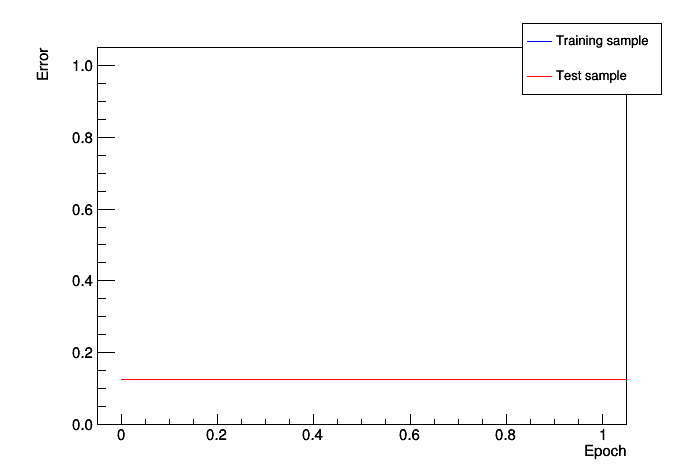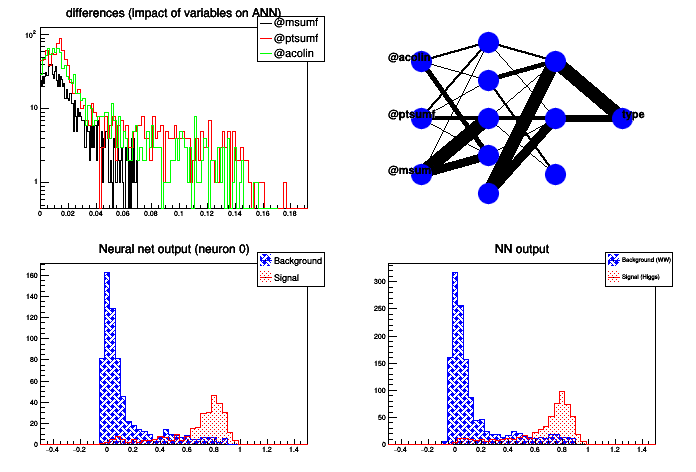
 Example of a Multi Layer Perceptron For a LEP search for invisible Higgs boson, a neural network was used to separate the signal from the background passing some selection cuts.
Example of a Multi Layer Perceptron For a LEP search for invisible Higgs boson, a neural network was used to separate the signal from the background passing some selection cuts.
Here is a simplified version of this network, taking into account only WW events.
Processing /mnt/vdb/lsf/workspace/root-makedoc-v608/rootspi/rdoc/src/v6-08-00-patches/tutorials/mlp/mlpHiggs.C...
accessing mlpHiggs.root file from http://root.cern.ch/files
Training the Neural Network
Epoch: 0 learn=0.126964 test=0.126101
Epoch: 10 learn=0.099816 test=0.0944112
Epoch: 20 learn=0.0967496 test=0.0914356
Epoch: 30 learn=0.0957444 test=0.0902211
Epoch: 40 learn=0.0929555 test=0.089151
Epoch: 50 learn=0.0922609 test=0.0886525
Epoch: 60 learn=0.0916939 test=0.0882441
Epoch: 70 learn=0.0910837 test=0.0879216
Epoch: 80 learn=0.0907021 test=0.0880823
Epoch: 90 learn=0.0901749 test=0.086813
Epoch: 99 learn=0.0901028 test=0.0863809
Training done.
test.py created.
Network with structure: @msumf,@ptsumf,@acolin:5:3:type
inputs with low values in the differences plot may not be needed
@msumf -> 0.016667 +/- 0.0132143
@ptsumf -> 0.0267861 +/- 0.0378194
@acolin -> 0.025739 +/- 0.0295963
void mlpHiggs(
Int_t ntrain=100) {
const char *fname = "mlpHiggs.root";
} else {
printf("accessing %s file from http://root.cern.ch/files\n",fname);
}
if (!input) return;
TTree *simu =
new TTree(
"MonteCarlo",
"Filtered Monte Carlo Events");
Float_t ptsumf, qelep, nch, msumf, minvis, acopl, acolin;
simu->
Branch(
"ptsumf", &ptsumf,
"ptsumf/F");
simu->
Branch(
"qelep", &qelep,
"qelep/F");
simu->
Branch(
"nch", &nch,
"nch/F");
simu->
Branch(
"msumf", &msumf,
"msumf/F");
simu->
Branch(
"minvis", &minvis,
"minvis/F");
simu->
Branch(
"acopl", &acopl,
"acopl/F");
simu->
Branch(
"acolin", &acolin,
"acolin/F");
simu->
Branch(
"type", &type,
"type/I");
type = 1;
for (i = 0; i < sig_filtered->
GetEntries(); i++) {
}
type = 0;
}
"ptsumf",simu,"Entry$%2","(Entry$+1)%2");
mlp->
Train(ntrain,
"text,graph,update=10");
ana.GatherInformations();
ana.CheckNetwork();
ana.DrawDInputs();
ana.DrawNetwork(0,"type==1","type==0");
TH1F *bg =
new TH1F(
"bgh",
"NN output", 50, -.5, 1.5);
TH1F *sig =
new TH1F(
"sigh",
"NN output", 50, -.5, 1.5);
params[0] = msumf;
params[1] = ptsumf;
params[2] = acolin;
}
for (i = 0; i < sig_filtered->
GetEntries(); i++) {
params[0] = msumf;
params[1] = ptsumf;
params[2] = acolin;
}
legend->
AddEntry(bg,
"Background (WW)");
legend->
AddEntry(sig,
"Signal (Higgs)");
delete input;
}
- Author
- Christophe Delaere
Definition in file mlpHiggs.C.



 Example of a Multi Layer Perceptron For a LEP search for invisible Higgs boson, a neural network was used to separate the signal from the background passing some selection cuts.
Example of a Multi Layer Perceptron For a LEP search for invisible Higgs boson, a neural network was used to separate the signal from the background passing some selection cuts. 
